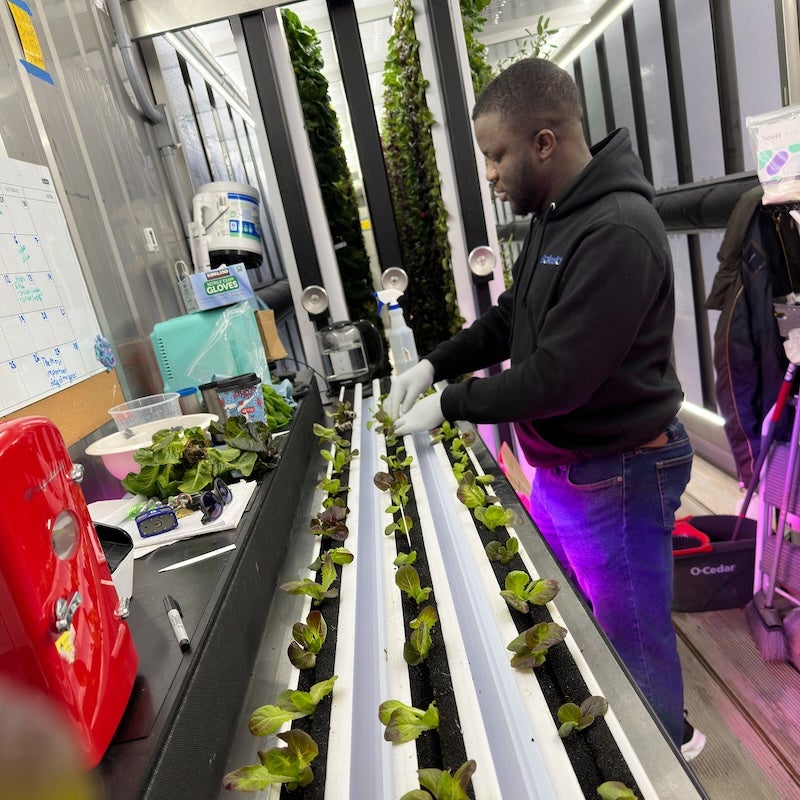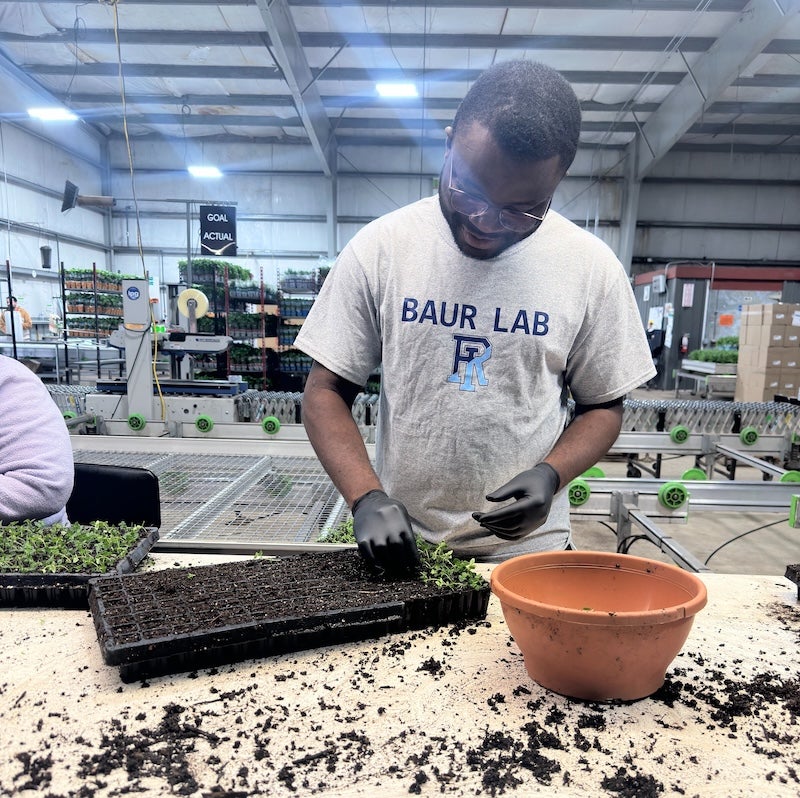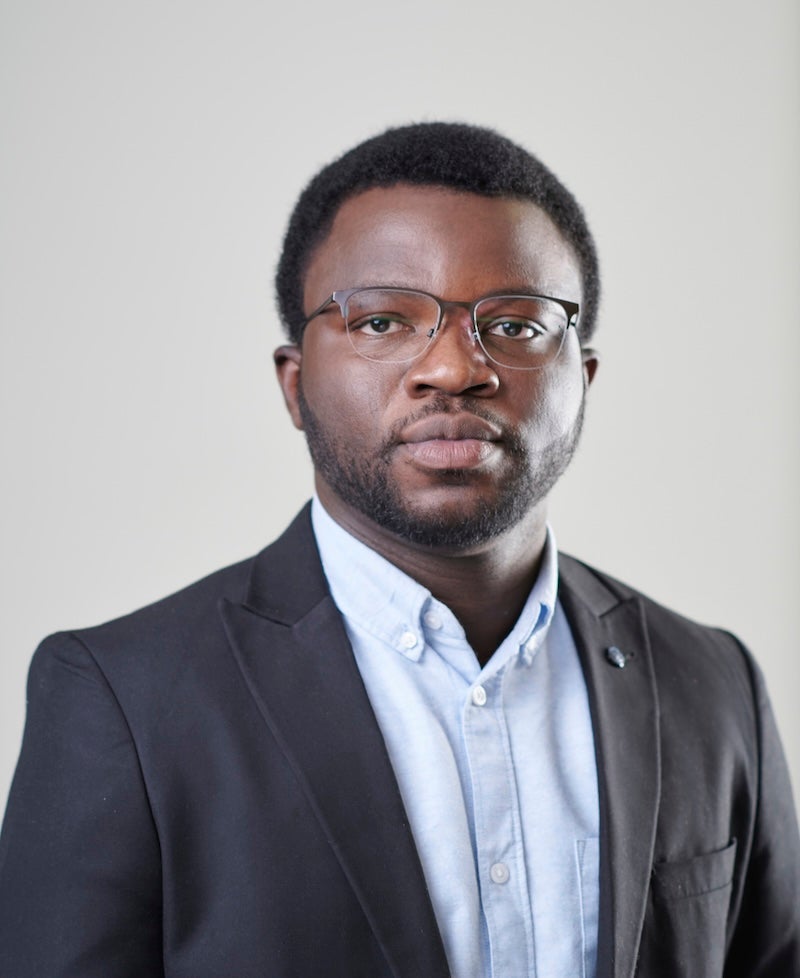Food systems in the United States increasingly utilize Controlled Environment Agriculture (CEA), a method in which plants are grown in environments that allow for light, temperature, and humidity to be controlled, such as greenhouses or vertical farms. While this method sounds ideal for sustainable agriculture–crops can be produced with less water and fertilizer and conditions can be optimized for success–studies on its sustainability have been limited. Sheriff Aliu, a Ph.D. candidate in Sustainable Agriculture and Food Systems from Offa, Nigeria, is working to change that. His dissertation research focuses on sustainability assessment for commercial CEA operations.
What are the impacts?
“I’ve always been fascinated by the tension between meeting present-day food needs and ensuring long-term sustainability, especially given what we know about ecological constraints and the mixed legacy of industrial agriculture,” Aliu says. “At its core, my research asks: When we bring high-tech farming into cities and communities, who benefits and who doesn’t? What are the real impacts on people, neighborhoods, and the environment?”
According to the U.S. Department of Agriculture, the number of Controlled Environment Agriculture operations in the United States more than doubled between 2009 and 2019, from 1,476 to 2,994. As Aliu began to research the motivations behind this growth, he found that the discourse around CEAs was theoretical or promotional in nature–an unhelpful “agricultural techsplaining” approach to an increasingly consequential method in the food system.
“There was a clear and urgent need for real-world, holistic data, and that was the inspiration for my dissertation,” he says. “I saw the opportunity to, at the very least, foreground and perhaps trailblaze situational and operational approaches to system sustainability in this rapidly evolving sector.”
The data he’s collected thus far suggests that large greenhouses tend to have stronger governance structures, but they only slightly outperform container farms–a modular, small-scale type of CEA system based on the idea of retrofitting a shipping contained into an indoor or vertical farm–in terms of environmental footprint.
“On the other hand, container farms often show greater economic resilience and make more tangible contributions to their local communities,” he says. However, these outcomes are not fixed; changing even one or two conditions–such as using renewable energy or providing employee benefits–can lead to very different results.

The story behind the numbers
While conducting his dissertation research, Aliu used participatory research methods to develop case studies of working CEAs in Missouri and New Jersey. This included working alongside CEA employees to carry out day-to-day tasks, observing operations, talking with people, and gathering data. “Some days I was packing produce into boxes; transplanting seedlings from the nursery to the grow channels, making deliveries to customers; or conducting interviews with workers, suppliers, and neighbors,” he says, “Other times, I was poring over company records or simply walking around the facility, observing daily operations and taking detailed notes.”
“It was both fun and rigorous,” he adds.
Moving beyond numbers is a crucial aspect of his approach. While his early review of existing research on CEA revealed the lack of studies on their sustainability, he also felt concerned about what he calls methodological monotony. “There was an overreliance on life cycle assessments and greenhouse gas emissions. While those metrics are important, they don’t tell the full story,” he says, noting that utilizing a mixed-methods approach has allowed him to investigate multiple dimensions of sustainability simultaneously.
“Ethnography gave me access to the lived realities of CEA operations: day-to-day routines, company records, and the perspectives of critical stakeholders across the value chain,” he says. “Taken together, these methods provide a much more nuanced and grounded picture of the sustainability realities of CEA.”
And despite the sense of Controlled Environment Agriculture systems being a futuristic, white-collar, automated innovation for agriculture, Aliu says he was surprised to realize how much physical labor is necessary for a successful operation. “As one participant put it, there’s still a lot of ‘janitorial’ work that keeps the system from collapsing,” he says. “That day-to-day maintenance is critical, yet often invisible in discourse. Low-cost robotics might help, as some companies practice, but that opens up an entirely different set of questions.”
“And although the sector brands itself as data-driven, most under-utilize their software platforms,” he adds. “Entering foundational data (e.g, planting date) demands staff time many operations can’t spare, or sensors and cameras that are priced out of their budget. We still know too little about these hidden labor costs and what they mean for sustainability in practice.”

Moving forward
Aliu says he was drawn to URI because most schools offer Sustainable Food Systems only as a certificate program. “URI was already ahead of the pack as it’s one of the few institutions with a fully-fledged, robust doctoral program in the field,” he says.
As soon as he connected with Professor Patrick Baur, he was excited to join the Baur Food Systems Lab. “He showed great commitment to ‘values-based’ mentoring, and I immediately felt safe and supported,” Aliu says. “I have a solid foundation in research design and execution, but the rigor, conceptual depth, and ‘philosophical novelty’ in his work were, quite frankly, next-level for me.”
“Sheriff has been a model student, and his doctoral research is very timely,” says Baur. “As with many novel technologies, there are a lot of bold projections that CEA will ‘change the world’. Sheriff is not only asking whether that promise is reflected in reality, but also developing tangible, evidence-based tools for systematically assessing the sustainability performance of CEA operations. His findings will be a major contribution both to the CEA industry and to policymakers at all levels looking at how to ensure this suite of agricultural strategies actually makes our lives better.”
Aliu plans to expand on this research in the future. “I’m particularly excited about exploring the synergies and trade-offs within CEA systems, starting with a fundamental question: how much control is enough control?” he says.
Finding the right balance is crucial, he notes, because something as minor as a two-degree temperature change can significantly affect energy costs, worker comfort, and plant growth. “I want to identify those key leverage points: small, actionable interventions that can have disproportionately large positive impacts on system sustainability, or conversely, unintended negative consequences.”
“There’s still much to unpack,” he adds, “and I plan to keep pushing that work forward.”

